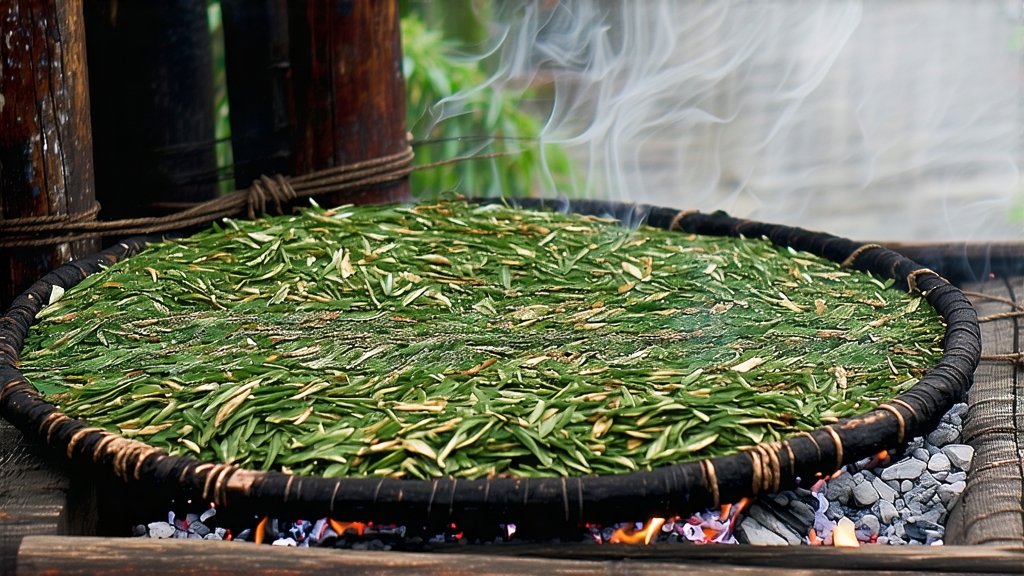
Long before Assam, Ceylon, or Earl Grey entered the global lexicon, the black-tea universe revolved around a tiny village in China’s Wuyi Mountains called Tongmu. There, sometime around 1568, a passing army forced tea farmers to rush their withering leaves over open pine fires so the crop would not spoil. The accidental marriage of tea and resinous smoke created Lapsang Souchong—literally “small-leaf variety from the original mountain”—and launched the very concept of fully oxidised tea. European merchants who tasted it in the early 1600s labelled the category “bohea,” a corruption of “Wuyi,” and for the next two centuries every shipment of black tea leaving Canton was measured against the smoky benchmark set by this rugged Fujian original.
Today the name Lapsang Souchong is applied to two very different teas. The commodity version, still produced in large woks over smouldering pine roar, delivers an assertive campfire punch familiar to Western breakfast blends. The second, increasingly rare, is the unsmoked “Zheng Shan Xiao Zhong” (Original Mountain Small Leaf) made only in Tongmu’s 600–1,200 m microclimate. Here the same cultivar—usually Wuyi Cai Cha or a proprietary qunti zhong—undergoes meticulous indoor withering, gentle charcoal roasting, and no smoke at all, yielding a sleek, cocoa-sweet liquor that recalls dried longan and malted rye. Both styles share a genealogy, yet sit at opposite poles of the sensory spectrum, proving that “Lapsang” is not a flavour but a place.
Craft begins in mid-April when the standard of “two and a half leaves” is plucked at dawn, the ambient mountain mist still clinging to the tiny, slightly purplish blades. The leaves are loaded onto bamboo trays in multi-tiered withering sheds where pine-log fires smoulder 1.5 m below the floor; only the rising warmth, not the smoke, is intended to reduce moisture to 60 %. Every twenty minutes the tea master shuffles trays, judging by hand-feel and aroma whether the grassiness has retreated and a ripe-fruit sweetness has emerged. Once the leaf becomes supple enough to twist without tearing, rolling commences—first mechanical kneading to rupture cells, then hand-pressing in linen bundles to encourage oxidation. The critical colour change from jade to copper must occur within 90 minutes; too slow and the tea tastes earthy, too fast and it flattens into generic tannin. For smoked versions, the semi-oxidised leaves are now spread on sieves suspended inside brick ovens where fresh pinewood is ignited, allowed to flame, then damped so that resin-rich smoke coils upward for three to four hours. The tea absorbs only the volatilised oils, not the tar, creating a clean, sweet smoke note that clings to the leaf surface rather than suffocating it. Finally, a 90 °C charcoal bake locks in fragrance and drops moisture below 7 %. Unsmoked lots skip the pine oven and instead rest above glowing embers of local hardwood until the master detects a whisper of honey on the cooling leaf.
To unlock either style’s full story, water is the first actor. Start with neutral spring water at 95 °C; anything harder emphasises tannin, while soft water mutes the smoke. Measure 4 g of leaf for a 150 ml gaiwan or 5 g for a 250 ml porcelain pot. Rinse once, pouring off within five seconds—this awakens the leaf and rinses away any travelling dust without sacrificing aromatics. The first proper infusion should last ten seconds, increasing by five each subsequent steep. Smoked Lapsang rewards short, sharp steeps that keep the camphor and pine in balance with underlying dried-date sweetness; unsmoked versions tolerate longer infusions, revealing layers of dark chocolate, ripe plum, and a mineral finish reminiscent of Wuyi rock oolong. Expect at least six infusions; the seventh often delivers a haunting brown-sugar note that surprises newcomers who assumed black tea was monolithic.
Professional cupping follows a tighter script. Use 3 g of leaf in a 150 ml ISO glass, infuse for five minutes at 100 °C, then evaluate wet aroma immediately: smoked lots should show crisp cedar and wintergreen, never ashtray; unsmoked lots should suggest roasted sweet potato and orchid. Liquor colour is judged against a white porcelain tile—smoked tea ranges from